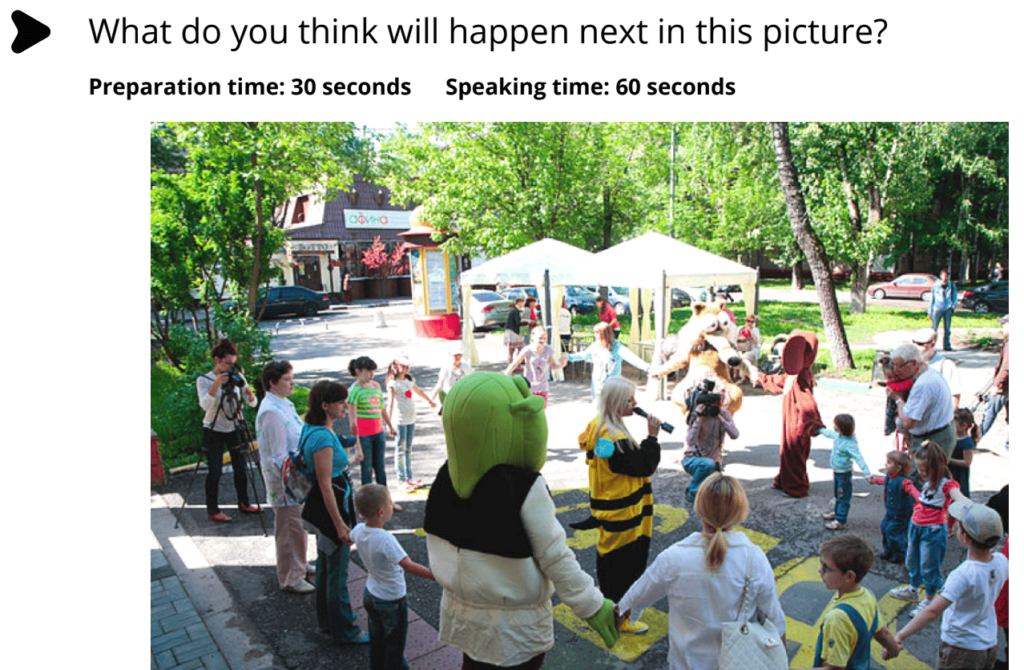CELPIP Study Guide: The Best Tips and Tricks!
This blog covers all the necessary CELPIP TIPS AND TRICKS with HZad Education’s very own Sean’s CELPIP Study Guide! Who is Sean? Simply the best CELPIP instructor in Canada and the CEO of HZad Education, the largest CELPIP tutoring company worldwide! Sean has compiled a comprehensive list here of everything you need to know along with:
- Free CELPIP Tutorials
- Free CELPIP Tips and Tricks
- Free CELPIP Mock Tests
- Best CELPIP Writing Samples
- Best CELPIP Speaking Samples
- Free CELPIP Videos, and a ton more!
Whether you are a first-time test-taker or someone with repeated CELPIP exam failures, this Study Guide is for you!
Buckle up, and let’s get started!
Firstly, what is CELPIP?
CELPIP is similar to IELTS in a way that is an English language test accepted by the Canadian government for immigration purposes. You can use your CELPIP score to apply for immigration through programs like Express Entry and PGWP, as it assesses your English proficiency in speaking, listening, reading, and writing. A high CELPIP score can improve your chances of being invited to apply for immigration.
To further your prep, we highly recommend you go with the best online CELPIP course that teaches you everything step-by-step (basic to advanced modules), with exam-like mock tests!
Next, what are the 4 components of the CELPIP exam and how is it formatted?
Here is how the CELPIP exam’s listening, reading, writing, and speaking sections are formatted:
| Section | Tasks | Timings | Examiner Expectations |
|---|---|---|---|
| Listening | 1. Listening to Problem-Solving 2. Listening to a Daily Conversation 3. Listening for Information 4. Listening to a News Item 5. Listening to a Discussion 6. Listening to Viewpoints |
47-55 minutes | Expect clarity in understanding spoken English, focus on extracting specific and general information, and comprehension of viewpoints and opinions. |
| Reading | 1. Reading Correspondence 2. Reading to Apply a Diagram 3. Reading for Information 4. Reading for Viewpoints |
55-60 minutes | Expect accurate comprehension of different texts, ability to interpret information, and strong understanding of written opinions and perspectives. |
| Writing | 1. Writing an Email (27 mins) 2. Responding to Survey Questions (26 mins) |
53-60 minutes | Expect a well-structured, coherent response with proper grammar, vocabulary, tone, and format. Ability to clearly express ideas and respond to prompts is essential. |
| Speaking | 1. Giving Advice (90 seconds speaking time) 2. Talking About a Personal Experience (60 seconds speaking time) 3. Describing a Scene (60 seconds speaking time) 4. Making Predictions (60 seconds speaking time) 5. Comparing and Persuading (60 seconds speaking time) 6. Dealing with a Difficult Situation (60 seconds speaking time) 7. Expressing Opinions (90 seconds speaking time) 8. Describing an Unusual Situation (60 seconds speaking time) |
15-20 minutes | Expect fluency, coherence, and clear communication. Examiners focus on pronunciation, sentence structure, and use of appropriate vocabulary for different contexts. |
For more detailed CELPIP scoring, refer to this website: https://www.celpip.ca/take-celpip/test-results/
Next, how many points do I need for my CLB?
MOST students need a CLB 7 or 9 for their immigration and study needs, however, it is best to consult an immigration lawyer regarding your personal requirements. Here is a breakdown of what CELPIP points you would need for the corresponding CLB level.
Note that CELPIP’s total score is 12 in each module.
________________________________________________________________________________________________________________
Why do students fail CELPIP? This course not only explains that but GUARANTEES your results or your MONEY-BACK! With 100,000 copies sold, check out why this course has internet’s best reviews (IMMEDIATE ACCESS AVAILABLE): https://hzadeducation.com/product/classes-celpip/
________________________________________________________________________________________________________________

CELPIP READING STUDY GUIDE:
Let’s start with probably the toughest section of the CELPIP exam: reading!
You have 4 parts in this section. Here, we will discuss Parts 1 and 4 together since they have the same format!
You see, in parts 1 and 4, you have the initial passage followed by 5-6 questions. Then, your next section will be in response to the initial section with another 5-6 questions. It looks something like this:
Section 1:

Section 2:

You will notice the questions in section 2 are embedded into a “RESPONSE” or a “COMMENT/REACTION” section. This is a comment/response/reaction to the initial passage and the answers here come from what you can EXPECT the commenter to say based on the first passage.
Note: All questions in CELPIP reading and listening are multiple-choice questions!
So, what’s the difference between parts 1 and 4 other than the formatting? Well, the difficulty! The difficulty level in CELPIP increases as you go from part 1 to 4 in reading, and from 1 to 6 in listening. This means that the words in part 4 will be very advanced and complex. Also, the words that are mentioned in the passage will be highly paraphrased when you see them in the questions.
BUT DON’T WORRY! We will come to some solutions later! Let’s continue with the format now:
Part 2 of your CELPIP Speaking is actually a picture! But not entirely! It’s a picture with some text. It will look something like this:

As you can see, the picture is almost like a brochure with some images and text. Right after this picture, you have about 8 questions that are related to the content in the picture.
Okay, now for Part 3, it’s paragraph matching! you have to match 4-5 paragraphs with 9-10 questions (statements). It is something like this:
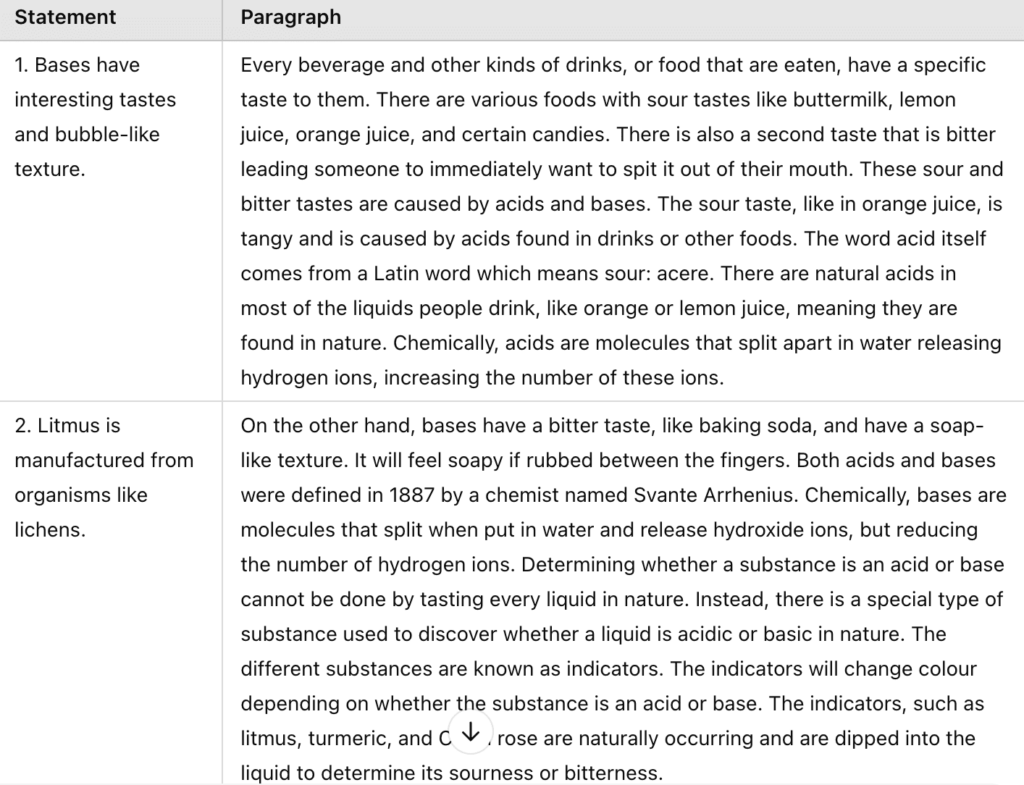
AND SO ON..
Of course, in the real exam, you have to match the statements with the right paragraphs that contain the information from the statement.
Now, let’s get into the BEST CELPIP READING TIPS AND TRICKS!
1. Understanding the Structure of CELPIP Reading Part 1
CELPIP Reading Part 1 is designed to assess your ability to comprehend and interpret written English in everyday contexts. Here’s what you need to know:
- Duration: You have 10 minutes to complete Part 1.
- Content: It includes a letter or email followed by multiple-choice questions.
- Questions: Typically, there are about 5-6 questions based on the initial letter.
- Response Letter: After the initial questions, you’re presented with a response letter and additional questions.
Understanding this structure is crucial for effective time management and strategizing your approach.
2. Timing is Everything: Managing Your Time Effectively
With only 10 minutes for this section, time is of the essence. Here’s how to make every second count:
- Questions per Minute: Aim to answer more than one question per minute.
- Prioritize Questions: Tackle the questions that are quicker to answer first.
- Save Time for Complex Questions: Allocate time at the end for more challenging questions that require interpretation.
Example: If you spend 2 minutes on a single difficult question, you risk not having enough time for the remaining ones. Prioritize efficiency!
3. Why Skimming is a Trap You Should Avoid
One common mistake is skimming through the passage before answering the questions. Here’s why that’s a bad idea:
- Ineffective Retention: Skimming often leads to forgetting key details.
- Time Waster: It can consume 30 seconds to a minute, which is 10% of your total time.
- Not Like Other Tests: Unlike other exams (e.g., IELTS), CELPIP doesn’t rely heavily on matching keywords.
Example: In IELTS, you might match keywords from the question to the text directly. In CELPIP, you need to interpret and understand the passage, which requires more in-depth reading.
4. The Best Strategy for Answering Questions
The most effective approach is a targeted question-first strategy.
- Step 1: Quick Overview – Spend 5 seconds to get the gist of the passage.
- Identify Tone: Is it formal or informal?
- Subject Matter: What’s the general topic? (e.g., a religious letter, a business email)
- Step 2: Read the First Question – Focus on what’s being asked.
- Step 3: Locate the Answer in the Passage – Find the relevant section.
- Step 4: Answer the Question – Choose the best option based on your understanding.
Identifying Key Phrases and Keywords
Keywords help you locate answers quickly.
- Good Keywords: Specific names, dates, places, or unique terms.
- Example: “David’s parents live in…”
- Strategy: Look for where the passage mentions David’s parents and their location.
Why It Works: These keywords point you directly to the relevant paragraph, saving time.
Handling Non-Keyword Questions
Some questions are non-keyword-based and require interpretation.
- Characteristics:
- Abstract Concepts: Main motives, overall themes.
- No Direct References: Can’t be found by scanning for specific words.
- Example: “The main motive behind this letter is…”
- Strategy: Understand the overall message and tone of the entire passage.
Tip: Skip these questions initially and return to them after answering the ones with clear keywords.
5. Is There a Sequence in the Questions?
A common question is whether the answers follow the order of the text.
- No Guaranteed Sequence: Unlike some tests, CELPIP doesn’t always present questions in the order of the passage.
- Example:
- Question 4 might require information from the first paragraph.
- Question 3 could be a general question requiring an understanding of the entire text.
Strategy: Don’t rely on the sequence. Treat each question independently and locate its answer accordingly.
6. Navigating Questions 7 to 11: The Response Letter
In the latter part of Part 1, you’ll face questions based on a response letter.
- Perspective Shift: You’re now answering from the viewpoint of the recipient responding to the original letter.
- Interpretation Over Retrieval: These questions test your ability to infer and predict responses.
- No Textual Evidence: Answers aren’t directly in the passage; they’re based on your understanding.
Example Strategy:
- Put Yourself in Their Shoes: Imagine you’re the recipient. How would you naturally respond?
- Use Context Clues: Rely on the tone and content of the original letter to guide your answers.
7. Example Analysis: Tackling a Tricky Question
Let’s dissect a complex question to illustrate the strategy.
Question 7:
“We are really thankful to you for giving ________.”
Options:
A. Your sincere gratitude
B. Sweet birthday greetings to me
C. Honest response
D. Encouragement
Step-by-Step Approach:
- Simplify Each Option:
- Your sincere gratitude: Did the original sender thank the recipient?
- Sweet birthday greetings to me: Were birthday greetings specifically given?
- Honest response: Is there a theme of honesty or a reply to a question?
- Encouragement: Did the sender offer words of encouragement?
- Refer to the Passage:
- Birthday Greetings: The sender says, “I wanted to take this opportunity to greet you happy birthday as well.”
- Encouragement: The sender offers uplifting words and possibly religious blessings.
- Eliminate Incorrect Options:
- Your sincere gratitude: The sender wasn’t thanking the recipient.
- Honest response: There’s no discussion about honesty or a reply to a previous concern.
- Choose the Best Answer:
- Between B and D: Both seem plausible.
- Specificity is Key: The passage explicitly mentions birthday greetings.
- Answer: B. Sweet birthday greetings to me
Why Not Encouragement?
- While the sender may offer encouraging words, the specific action they took was sending birthday greetings.
8. Conclusion: Be Smart with Your Strategy
Mastering CELPIP Reading Part 1 requires a combination of time management, strategic reading, and critical thinking.
Key Takeaways:
- Avoid Skimming: It wastes time and doesn’t aid in understanding.
- Use a Targeted Approach: Read the question first, then find the answer.
- Identify Keywords: They help locate answers quickly.
- Handle Non-Keyword Questions Last: Tackle them after gaining a full understanding of the passage.
- Understand the Passage: Interpretation is crucial, especially for response letters.
- Practice Makes Perfect: Familiarize yourself with these strategies through practice tests.
1. Understanding the Structure of CELPIP Reading Part 2
In Part 2 of the CELPIP Reading Test, you’ll encounter a different format:
- Visual Stimulus: Instead of a traditional text passage, you’re presented with an image or diagram that contains embedded text.
- Questions: You’ll answer multiple-choice questions based on the information in the image.
- Duration: You have 8 minutes to complete this section.
Key Point: This part assesses your ability to quickly interpret visual information and extract relevant details.
2. Effective Strategies for Visual Texts
Approaching visual texts requires a different strategy:
- Initial Review: Spend 1-2 minutes thoroughly examining the image.
- Understand the Hierarchy: Identify headings, subheadings, and any hierarchical structures.
- Note Key Features: Pay attention to bold text, bullet points, and any highlighted information.
Example: If the image is a flyer advertising different ticket tiers for an event, note the features and benefits of each tier.
3. Time Management: Making the Most of 8 Minutes
With only 8 minutes, efficient time management is crucial:
- 1-2 Minutes: Review the image and get a general understanding.
- 6-7 Minutes: Answer the questions, referring back to the image as needed.
Tip: Unlike Part 1, in Part 2, you should review the image before looking at the questions.
4. Interpreting the Image: What to Look For
When examining the image:
- Overall Idea: Understand the main purpose of the image.
- Specific Details: Note any specific features, such as prices, benefits, limitations, or special offers.
- Comparisons: Identify any comparative information, such as differences between ticket tiers or product options.
Example (imagine a brochure showing you ticket options):
- Ticket Tiers: Basic, Red, Golden, VIP.
- Features:
- Basic: Farthest seats, limited access, no refunds or upgrades.
- Red: Closer seats (10 meters away), some perks like fast-food options and reasonable sound.
- Golden: First-row seats, special offers, but potential safety concerns.
- VIP: Backstage access, premium benefits, best experience.
Key Point: Understanding these distinctions is essential for answering comparison-based questions.
5. Navigating the Questions: From General to Specific
After reviewing the image:
- Read the Questions Carefully: Identify keywords and what is being asked.
- Look for Tricky Phrases: Words like “except”, “not”, or “however” can change the meaning significantly.
- Refer Back to the Image: Use the image to confirm your answers.
Example Question:
Going from Basic to VIP tickets, everything increases except:
- A. Price
- B. Closeness to the stage
- C. Safety
- D. Sound quality
Strategy:
- Identify Keywords: “Basic to VIP,” “increases,” “except.”
- Process of Elimination:
- Price: Likely increases.
- Closeness to Stage: Increases.
- Sound Quality: Likely improves.
- Safety: May have issues (e.g., VIP may have safety concerns due to proximity).
- Answer: C. Safety
Why? In the image, VIP tickets mention potential safety concerns, such as players running into the front row.
6. Example Analysis: Tackling a Sample Question
The next set of questions is based on the initial conversation between two people regarding the image. Let’s delve deeper into an example to illustrate the strategy.
Sample Question:
Jeremy and Ronaldo are most likely:
- A. Best friends
- B. Friends
- C. Close friends
- D. Acquaintances
Approach:
- Eliminate Unlikely Options:
- Acquaintances: Too distant for the context (discussing event plans).
- Consider the Tone:
- The message is casual and enthusiastic.
- Phrases like “Hey Ray, how’s it going?” suggest familiarity.
- Differentiate Between Options:
- Best Friends: Implies a very close relationship.
- Close Friends: A strong friendship but perhaps not as intimate as “best friends.”
- Friends: A general term.
- Analyze the Context:
- They’re discussing attending an event together.
- Sharing detailed information about ticket options.
- The informal language indicates they are more than just friends.
- Choose the Most Appropriate Option:
- Answer: C. Close friends
Reasoning: The tone and content suggest they are more than casual friends but may not necessarily be “best friends.”
Note: Being specific is crucial. Without explicit evidence of them being “best friends,” “close friends” is the most accurate choice.
7. Conclusion: Sharpen Your Visual Interpretation Skills
CELPIP Reading Part 2 challenges you to interpret visual information efficiently. By applying the right strategies, you can navigate this section with confidence.
Key Takeaways:
- Review the Image First: Spend 1-2 minutes understanding the visual.
- Identify Key Features: Note important details and hierarchical structures.
- Be Wary of Tricky Wording: Pay attention to words like “except” or “however.”
- Use Process of Elimination: Narrow down options by eliminating unlikely answers.
- Interpret the Tone: For questions about relationships or sentiments, consider the overall tone.
(COMPLETE ONE-HOUR VIDEO Explaining These Strategies in Detail: https://www.youtube.com/watch?v=6WW_Msk5geA&t=1918s)
1. Understanding CELPIP Reading Part 3
Overview
In Part 3 of the CELPIP Reading Test, you’ll encounter several paragraphs labeled A, B, C, D, and sometimes E, which represents content not mentioned in the text. Following the paragraphs, there are statements (not questions) that you need to match with the appropriate paragraphs.
The Matching Task Explained
Your task is to match each statement to the paragraph that it best describes or relates to. For example:
- Statement: “An inflation rate has soared.”
- Task: Find the paragraph where this idea is expressed. If it’s in Paragraph D, you match it accordingly.
Important: Ensure that every part of the statement aligns with the content in the paragraph. Partial matches are not sufficient.
Example:
- If a statement mentions “inflation rate has soared” and the paragraph only discusses “inflation rate” without indicating it has soared, then it’s not a match.
Common Mistakes to Avoid
Many test-takers fall into traps by applying incorrect strategies, often borrowed from other exams like IELTS. Here are common pitfalls:
1. Treating It Like an IELTS Heading Match
- Mistake: Trying to find the main idea or heading of each paragraph.
- Why It’s Wrong: CELPIP’s matching task requires you to find specific details, not just the main idea.
2. Reading Only First and Last Sentences
- Mistake: Skimming the first and last sentences, assuming they’ll contain the key information.
- Why It’s Wrong: Important details can be located anywhere in the paragraph.
3. Looking for Answers Sequentially
- Mistake: Attempting to find the answer to Statement 1 before moving to Statement 2.
- Why It’s Wrong: Statements can relate to any paragraph in any order, and paragraphs may match multiple statements.
Tip: Always read the entire paragraph carefully before matching statements.
Effective Reading Strategies
To efficiently tackle Part 3, adopt the following approach:
Step 1: Read One Paragraph at a Time
- Focus: Fully understand Paragraph A before moving on.
- Method:
- Read the paragraph thoroughly.
- Summarize it in your own words.
- Identify key points and concepts.
Step 2: Summarize and Paraphrase
- Why: Paraphrasing helps you internalize the content and recognize paraphrased statements in the questions.
- How:
- After reading, briefly explain the paragraph to yourself.
- Note down the main ideas and any significant details.
Step 3: Match Statements to the Paragraph
- Process:
- Go through the statements.
- See which ones align with your understanding of the paragraph.
- Remember, multiple statements can match a single paragraph.
Example Analysis: Tackling a Complex Question
Let’s analyze a sample question to illustrate the strategy.
Paragraph A Summary:
- Event: Historic referendum in June 2016 in the UK.
- Topic: Whether the UK should remain in or leave the European Union (EU).
- Term: The possibility of leaving became known as Brexit.
- Participation: Over 30 million people voted, higher than the last general election.
- Eligibility: British, Irish, Commonwealth citizens aged 18+, and UK citizens abroad for under 15 years.
Sample Statement:
- “A number of people voted for Britain’s departure from the membership of the European Union.”
Analysis:
- Match Keywords: “Voted,” “Britain’s departure,” “European Union.”
- Check Paragraph A:
- It mentions 30 million people voted.
- The referendum was about whether to remain or leave the EU.
- Consideration:
- The paragraph states the number of people who voted, but doesn’t specify how they voted.
- The statement implies people voted for departure, which is a specific outcome.
Decision:
- Is the Statement Fully Supported?
- Partially: The paragraph confirms people voted on the issue but doesn’t specify they voted for departure.
- Conclusion:
- Potential Match: Since the paragraph is about the vote concerning departure, and the large turnout, it’s reasonable to match the statement to Paragraph A.
Note on Complexity:
- Sometimes, statements may seem to match partially. In such cases, consider:
- Does the paragraph explicitly or implicitly support the entire statement?
- Is there any contradictory information?
Tip: Be cautious with assumptions. If in doubt, and if a statement isn’t fully supported, consider that it might be ‘Not Mentioned’ (Option E).
Dealing with ‘Not Mentioned’ Statements
In CELPIP Reading Part 3, Option E represents content not mentioned in any of the paragraphs.
How to Handle ‘Not Mentioned’ Statements:
- After Matching All Statements:
- Once you’ve matched the statements you’re confident about, any remaining statements are likely ‘Not Mentioned’.
- Avoid Wasting Time Searching for E:
- There’s no need to find a paragraph for Option E.
- Simply assign E to statements that don’t match any paragraph.
Example:
- If Statement 4 doesn’t match any paragraphs after careful consideration, mark it as E.
Tip: Ensure you’ve thoroughly checked all paragraphs before assigning ‘Not Mentioned’ to a statement.
____________
FREE PDF – THE HARDEST CELPIP READING PRACTICE TEST: https://www.youtube.com/watch?v=7af-yzLUUVk&t=6s
_____________
1. Understanding CELPIP Reading Part 4
CELPIP Reading Part 4 is designed to assess your ability to comprehend and analyze complex texts. Here’s what you need to know:
- Complexity: The passages are longer and feature advanced vocabulary akin to academic texts.
- Format: Similar to Part 1, with an initial passage followed by multiple-choice questions and a response letter.
- Time Management: You’ll need to read efficiently to answer all questions within the allotted time.
Key Point: Mastery of Part 4 can significantly boost your overall CELPIP score.
2. Key Features of Part 4
Before diving into strategies, let’s understand what makes Part 4 unique:
- Non-Sequential Questions: Unlike other sections, the questions are not in the order of the passage.
- Advanced Vocabulary: Expect challenging words and phrases that require a strong vocabulary.
- Heavily Paraphrased Questions and Options: Direct matches between the passage and the options are rare.
- Use of Negative Phrasing: Questions often include words like “not”, “except”, or “disagree”.
Example:
- “Which of the following is NOT mentioned by the author?”
Tip: Being aware of these features can help you tailor your approach effectively.
3. Effective Strategies for Part 4
Dealing with Non-Sequential Questions
Challenge: Questions are scattered and do not follow the passage’s order.
Strategy:
- Skim the Entire Passage First: Get a general understanding of the main ideas and structure.
- Annotate Key Points: Note where significant topics or arguments are located.
- Refer Back as Needed: For each question, go back to the relevant section.
Example:
- Question 2 might relate to the final paragraph. Knowing this can save time.
Handling Complex Vocabulary
Challenge: Advanced vocabulary can impede understanding.
Strategy:
- Build Your Vocabulary: Regularly read academic articles, journals, and advanced texts.
- Use Context Clues: Infer meanings based on surrounding words and sentences.
- Create a Vocabulary List: Keep track of unfamiliar words and their definitions.
Example:
- Word: “Clout-chaser”
- Meaning: Someone seeking popularity or influence.
- Context: “They are creating a clout-chaser mentality among the youth…”
Tip: Familiarity with such terms can enhance comprehension and speed.
Navigating Heavily Paraphrased Questions
Challenge: Questions and options are reworded, making direct matches difficult.
Strategy:
- Understand Concepts, Not Just Words: Focus on the underlying ideas.
- Paraphrase in Your Own Words: Restate the passage’s points to better recognize paraphrased options.
- Eliminate Wrong Answers: Use process of elimination to narrow down choices.
Example:
- Passage Idea: “Young people are excessively focused on gaining popularity through technology.”
- Paraphrased Option: “They like to be popular.”
Approaching Negative Questions
Challenge: Questions that ask for exceptions or negatives can be confusing.
Strategy:
- Highlight Negative Words: Circle or underline words like “not”, “except”, “disagree”.
- Rephrase the Question Positively: Understand what is being asked in simpler terms.
- Carefully Analyze Each Option: Ensure that you are selecting the option that correctly answers the negative question.
Example:
- Question: “Which of the following does the author disagree with?”
- Approach:
- Identify the author’s viewpoints.
- Match options with the author’s opinions.
- Choose the option that contradicts the author’s stance.
Tip: Paying close attention to these words prevents careless mistakes.
4. Example Analysis: Tackling Difficult Questions
Let’s apply these strategies to sample questions for better understanding.
Understanding the Debate Structure
Context:
- Passage: An article featuring a debate between Robert Houston, who criticizes technology, and Randall Jones, who supports it.
- Task: Answer questions based on their viewpoints.
Importance:
- Knowing each person’s stance helps in answering questions about their opinions, disagreements, and perspectives.
Strategy and Example:
- Summarize Each Viewpoint:
- Robert Houston: Believes technology has negative impacts, especially on youth.
- Randall Jones: Emphasizes the benefits and positive aspects of technology.
Analyzing Tone and Stance
Sample Question:
How would Jones probably view Houston?
Options:
A. Skeptic
B. Realist
C. Pessimist
D. We cannot say for sure
Approach:
- Identify Jones’s Perspective:
- Jones is pro-technology.
- Consider How Jones Might View Someone Anti-Technology:
- Likely sees Houston as a pessimist or skeptic.
- Look for Direct Evidence:
- Does Jones explicitly label Houston?
- No direct comments from Jones about Houston are present.
- Eliminate Options:
- Realist: Unlikely, as they have opposing views.
- Pessimist: Possible, but no direct evidence.
- Skeptic: Possible, but again, no direct mention.
- Select the Most Accurate Option:
- Answer: D. We cannot say for sure
Reasoning: Without explicit statements, we can’t definitively determine Jones’s view of Houston.
Eliminating Close Options
Sample Question:
How can anyone in their right mind be as ______ towards technology’s cons as Randall?
Options:
A. Aware
B. Educated
C. Ignorant
D. Dedicated
Approach:
- Analyze the Sentence Tone:
- The phrase “How can anyone in their right mind…” indicates criticism.
- Determine the Missing Word’s Connotation:
- Likely a negative word.
- Evaluate Options:
- Aware, Educated, Dedicated: Positive connotations.
- Ignorant: Negative connotation.
- Select the Best Fit:
- Answer: C. Ignorant
Tip: When three options are positive and one is negative in a critical context, the negative option is likely correct.
5. Conclusion: Succeeding in Part 4
CELPIP Reading Part 4 may be challenging, but with the right strategies, you can navigate it successfully.
Key Takeaways:
- Understand the Structure: Recognize that questions are non-sequential and passages may involve debates.
- Enhance Your Vocabulary: Regular practice with advanced texts will improve comprehension.
- Read Actively: Summarize, paraphrase, and annotate as you read.
- Pay Attention to Tone and Stance: Understanding the author’s and commenters’ perspectives is crucial.
- Handle Negative Questions Carefully: Highlight and interpret negative phrasing accurately.
- Use Process of Elimination: Narrow down options by eliminating clearly incorrect answers.
Want to practice all of the above in action?
TRY OUT HZAD EDUCATION’S 5 CELPIP MOCK TESTS COMPLETELY FREE HERE: https://hzadeducation.com/product/5-celpip-mock-tests-feedback/
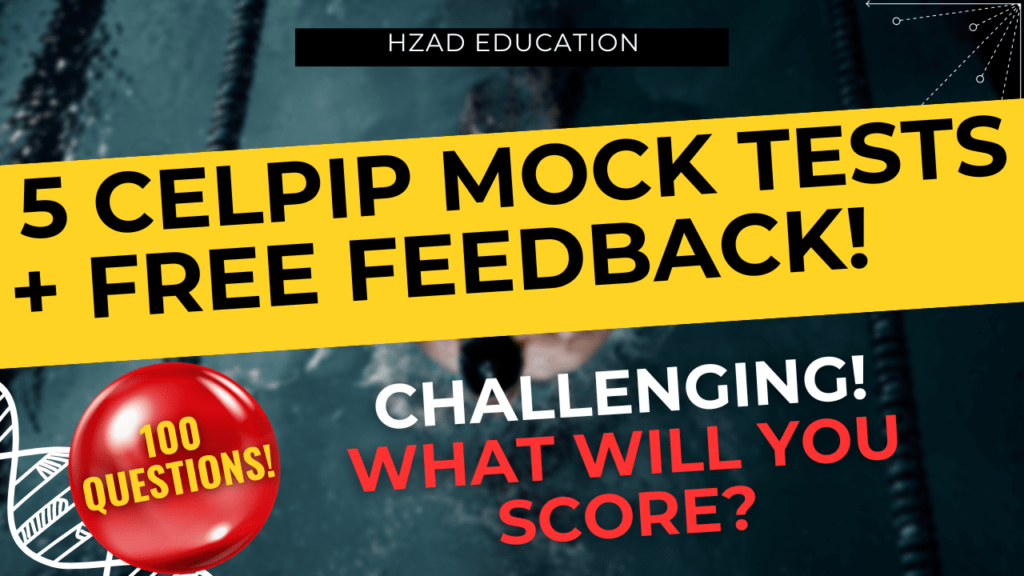
CELPIP LISTENING TIPS AND TRICKS:
Now, let’s talk about CELPIP listening as this is the module where you have to FIRST LISTEN and THEN SEE THE QUESTIONS. Yes, that is correct. This is not like IELTS or other exams where you get the questions along with the listening audio. Here, you FIRST hear the audio, THEN, you get questions that follow. This means you need to TAKE NOTES. Let me repeat that. You need to TAKE NOTES! This is the main and the most important strategy in CELPIP listening.
There is no way you will ever remember everything that is said in the recordings, hence, your notes will be your best friend! They will help you remember what was said initially and you can rely on them to have the info you need to answer the questions that will later show up on your screen.
To further understand how the listening section and its 6 parts work in the exam, refer to this video: https://www.youtube.com/watch?v=s0ssTBsRkuY&t=159s
Also, remember, note-taking can be messy and that’s fine! Who cares! You are taking notes for yourself. The examiner will never see them. So make good use of the pen and paper you have been given and take down as many points as you need to write whether it’s messy writing, weird images, or colloquial language! As long as those words and phrases remind you of the transcript, you are gold!
Top 10 CELPIP Listening Tips to Achieve High Scores:
1. Familiarize Yourself with the Exam Format
Don’t enter the exam room unprepared. Understanding the structure of the CELPIP Listening Test is crucial for success.
- Sections and Parts: Know how many parts there are and what each entails.
- Timing: Be aware of how much time you have for each section.
- Question Types: Understand the different question formats you might encounter.
Example: If you know that Part 3 involves listening to a conversation between two people, you can prepare by practicing dialogues and focusing on identifying speakers’ opinions.
Once again, practicing with HZad Education’s FREE Mock Tests will give you the real experience and have you well-prepared!
2. Focus on the First Few Seconds
The beginning of each audio clip is critical. Important hints and context are often provided in the first few seconds.
- Initial Reactions: Sometimes, the speakers express their feelings right at the start.
- Setting the Scene: The opening lines can provide the topic and tone of the conversation.
Example:
- Speaker A: “Oh my, I can’t believe this happened!”
- Possible Question: “How was the lady initially responding?”
- Answer: She was surprised or shocked.
Action Steps:
- Be Ready Immediately: As soon as the audio starts, focus your attention.
- Take Quick Notes: Jot down any initial reactions or emotions expressed.
3. Listen for the Main Idea, Not the Noise
Don’t get lost in unnecessary details. Speakers may include extraneous information to distract you.
- Identify Key Points: Focus on what is truly important in the conversation.
- Avoid Red Herrings: Ignore filler words and off-topic remarks.
Example:
- Speaker: “I’ve been thinking for a long time that I should probably move. It’s something that was really hard for me to think about, but yeah, I’ve been thinking about it a lot.”
- Main Idea: The speaker is considering moving.
- What to Note: “Thinking about moving.”
Action Steps:
- Note the Main Ideas: Write down the core points being discussed.
- Don’t Overwrite: Avoid writing down every word; it’s inefficient and unnecessary.
Tip: Focusing on the main ideas ensures you capture the essential information needed for correct answers.
4. Take Effective Notes
Note-taking is a crucial skill in the CELPIP Listening Test.
- Multitask: You need to listen and write simultaneously.
- Memory Aids: Use your notes to jog your memory when answering questions.
Strategies:
- Abbreviations and Symbols: Use shorthand to write quickly.
- Visual Aids: Draw arrows, diagrams, or emoticons to represent ideas.
Example:
- Speaker: “I saw Bob yesterday, and he was fuming with anger.”
- Note: Write “Bob 😠” or “Bob—angry.”
Action Steps:
- Practice Note-Taking: During practice sessions, focus on improving your speed and efficiency.
- Review and Refine: After each practice, evaluate your notes to see what worked and what didn’t.
Tip: Effective note-taking leads to better recall and higher accuracy in answers.
5. Practice Paraphrasing
Develop the ability to rephrase spoken content in your own words.
- Understand Fully: Paraphrasing ensures you have comprehended the material.
- Avoid Traps: Questions may use synonyms or reworded phrases to test your understanding.
Example Exercise:
- Step 1: Listen to a sentence or two from a YouTube video.
- Step 2: Pause and restate the content in your own words.
- Goal: Use less than 50% of the original wording.
Action Steps:
- Regular Practice: Incorporate paraphrasing exercises into your study routine.
- Increase Complexity: Start with short sentences and gradually move to longer passages.
Tip: Mastering paraphrasing can help you avoid being tricked by reworded questions.
6. Pay Attention to Transition Words
Transition words signal shifts in ideas or opinions.
- Common Transition Words: However, furthermore, nevertheless, next.
- Significance: They indicate contrasts, additions, or conclusions.
Example:
- Speaker: “I thought the movie was going to be boring. However, it turned out to be quite exciting.”
- Note: The speaker changed their opinion after watching the movie.
Action Steps:
- Highlight Transitions: When taking notes, mark transition words clearly.
- Organize Notes Accordingly: Separate different ideas or opinions for clarity.
Tip: Recognizing transitions helps you understand the structure and flow of the conversation.
7. Improve Your Vocabulary
A strong vocabulary enhances comprehension.
- Encounter Unfamiliar Words: Advanced vocabulary might appear in the test.
- Context Clues: Use surrounding words to infer meanings.
Strategies:
- Vocabulary Lists: Study CELPIP-specific word lists with over 800 words.
- Daily Practice: Learn 20 to 30 new words each day.
- Usage: Create sentences using new words to solidify understanding.
Example:
- Word: “Encapsulate”
- Meaning: To summarize or condense.
- Sentence: “The conclusion encapsulated the main points of the essay.”
Action Steps:
- Read and Listen: Engage with English media like TV shows, interviews, and movies, especially in the Canadian accent.
- Note New Words: Write down unfamiliar words and look up their meanings.
Tip: A robust vocabulary allows for better understanding and fewer misunderstandings during the test.
8. Watch Out for Distractors
Don’t be misled by plausible but incorrect options.
- Multiple Correct-Looking Answers: Sometimes, all options may seem correct.
- Best Answer: Choose the one that best fits the question.
Example:
- Question: “Which method does the speaker recommend?”
- Options:
- A. Method A
- B. Method B
- C. Method C
- D. Improved methods (encompassing A, B, and C)
- Answer: D. Improved methods, because it encapsulates all the methods discussed.
Action Steps:
- Read All Options Carefully: Don’t select the first option that seems correct.
- Eliminate Carefully: Rule out options by identifying inconsistencies with the audio.
Tip: Being vigilant about distractors ensures you select the most accurate answer.
9. Listen for Tone and Emotion
Understanding the speaker’s feelings can provide context and clues.
- Emotional Cues: Listen for happiness, sadness, frustration, etc.
- Emphasis and Intonation: Note when speakers stress certain words or phrases.
Example:
- Speaker: “I am extremely happy with the results!”
- Tone: Elation and satisfaction.
- Possible Question: “How does the speaker feel about the results?”
- Answer: Very pleased or delighted.
Action Steps:
- Practice Active Listening: Pay attention to not just what is said but how it’s said.
- Note Emotional Language: Write down words that indicate feelings.
Tip: Grasping tone and emotion can help answer questions about the speaker’s attitude or feelings.
10. Analyze the Video in Part 5
Part 5 includes a video component—make the most of it.
- Visual Cues: Observe facial expressions and body language.
- Audio and Visual Synchronization: Ensure what you hear aligns with what you see.
Strategies:
- Facial Expressions: Note if the person is smiling, frowning, or showing other emotions.
- Body Language: Crossed arms might indicate defensiveness; leaning forward can show interest.
Example:
- Observation: The speaker smiles widely and leans forward while saying, “This is terrific!”
- Inference: The speaker is enthusiastic and positive about the subject.
Action Steps:
- Combine Audio and Visual: Use both sets of cues to fully understand the context.
- Practice with Videos: Watch English videos and practice interpreting both verbal and non-verbal messages.
Tip: Effective analysis of the video can lead to correct answers in this unique section of the test.
Conclusion
By incorporating these 10 essential CELPIP Listening tips into your preparation, you’ll enhance your ability to comprehend and interpret the audio components of the test effectively. Remember to:
- Practice Regularly: Consistency is key to improvement.
- Evaluate Yourself: After practice sessions, assess what you did well and what needs improvement.
- Stay Calm and Focused: Confidence and concentration can significantly impact your performance.
Next Steps:
- Start with Tip #1: Familiarize yourself with the exam format by checking out comprehensive CELPIP courses and mock tests.
- Engage with us: If you have questions, feel free to email us at [email protected] for free advice!
REMINDER!!!
Your Main Goals in CELPIP:
CHECK OUT THESE STUDENT RESULTS. These are all students of HZad Education:
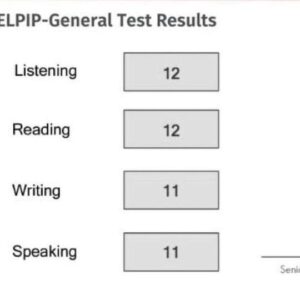
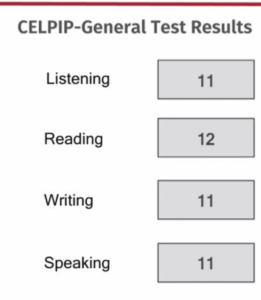

In fact, check out even more HZad Education’s CELPIP course reviews here: https://youtu.be/57_qn8oYnJ8
If you want to score like the candidates above and the 65,000+ students who have already used our secret sauce that GUARANTEES a 10+ every time, you have to check out our CELPIP 15-hr (also internet’s most popular) online course here: https://hzadeducation.com/product/classes-celpip/
“GUARANTEED CLB IMPROVEMENT OR YOUR MONEY BACK!”
Now, let’s move on to perhaps the hardest module in the CELPIP exam…
CELPIP SPEAKING + TIPS AND TRICKS!
The CELPIP speaking section contains of 8 parts. Each part has its own unique set of instructions.
Here, you are NOT talking to any examiner. Instead, you will be shown all questions on your screen and you have to record your answers. Each question has a preparation and an answer time. These times have been mentioned in the tasks below.
What we will do is instead of beating around the bush, in this guide, we will explore every single question with a speaking sample answer and a breakdown of why this would score highly! Ready? Here we go:
Question 1:

Tips to Answer the Question:
- Analyze the situation: Understand the key points—your sibling is getting addicted to caffeine, and you need to offer solutions.
- Organize your thoughts: Begin with a brief introduction to the problem, followed by clear, practical steps. Prioritize clarity.
- Use varied sentence structures: Include a mix of compound and complex sentences to enhance the quality of your response.
- Give specific examples: Support your advice with relevant examples to make it more convincing.
- Conclude with encouragement: End on a positive note to show your support and motivation for your sibling.
Sample Answer
Hey, I noticed that you’ve been consuming a lot of caffeine lately, and I’m concerned it might be turning into an addiction. While caffeine can give you a temporary boost, it can also lead to dependency and health issues like anxiety and insomnia. To cut back, the first step is to gradually reduce your intake. You don’t need to stop cold turkey, but you can start by replacing one cup of coffee with herbal tea or water. This way, you can slowly reduce your caffeine dependence without experiencing withdrawal symptoms.
Another effective approach is to replace the habit of reaching for a coffee with physical activities like a short walk or some stretches. These can naturally energize you and help break the routine of relying on caffeine. You should also try getting more sleep at night so you don’t feel the need for caffeine to stay awake during the day.
Finally, stay patient with yourself. Breaking any habit takes time, but with persistence, you’ll feel much better without having to rely on caffeine for energy. I’m here to help you throughout the process, so let’s tackle this together!
Question 2:

Tips to Answer the Question:
- Identify a clear regret: Choose a significant event or decision that can be explained concisely.
- Describe your feelings: Focus on how the regret impacted you emotionally.
- Explain what you learned: Show personal growth or realization as a result of the regret.
- Use varied sentence structures: Mix complex and compound sentences to demonstrate fluency.
- Conclude positively: End on a note of growth or understanding.
Sample Answer
One of my biggest regrets is not seizing the opportunity to study abroad during university. I was offered a chance to attend a prestigious program in Europe, but at the time, I hesitated due to fear of leaving my comfort zone. I was concerned about being far from home and the challenges of adapting to a new culture. Looking back, I realize that this would have been an invaluable experience, both personally and academically.
This decision has haunted me because I know it would have expanded my horizons and opened doors to new opportunities. The regret left me feeling that I missed out on something significant, but it also taught me a valuable lesson: to embrace risks and new experiences when they arise. Now, I’m more open to stepping outside my comfort zone, knowing that such moments are the ones that lead to the most growth.
Question 3:
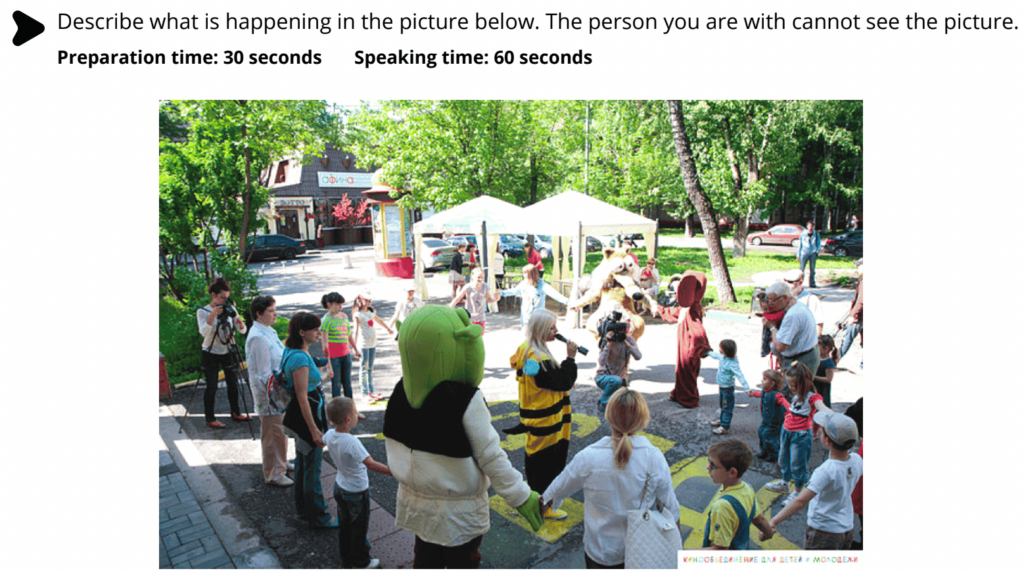
Tips to Answer the Question:
- Describe the scene in detail: Imagine the listener cannot see anything, so you need to be vivid and descriptive.
- Mention key details: Focus on what is happening, the people involved, and the environment.
- Keep the description clear and structured: Begin by setting the scene, describe the key actions, and finish by giving an overall impression.
Sample Answer
In this picture, there seems to be a lively outdoor event taking place. A group of children, along with some adults, are holding hands in a large circle. At the center, there are people dressed in colorful costumes, including a character resembling Shrek and another in a bee costume. It looks like they are leading some kind of interactive activity or game with the children. There’s also someone with a microphone, possibly entertaining or giving instructions to the group. In the background, there’s a white tent, and we can see trees, parked cars, and other adults watching the event. The atmosphere seems festive and cheerful, with everyone engaged and smiling. Some people are even taking pictures, capturing the moment. It appears to be a family-friendly gathering, perhaps a celebration or a children’s party happening in a park or recreational area.
Question 4:
Tips to Answer the Question:
- Predict logically: Use clues from the image to make a reasonable prediction.
- Focus on actions: Think about what the participants are likely to do next based on the context.
- Structure the response: First, explain your prediction, then provide reasons for it.
- Use advanced language: Include complex sentences and descriptive phrases.
Sample Answer
Looking at this picture, I predict that the next activity will likely involve some sort of interactive game or performance. Since the children and adults are holding hands in a circle, it seems like they might start a group activity, such as a dance or a game that requires everyone’s participation. The person with the microphone may begin leading the group by giving instructions, and the costumed characters will probably play a major role in keeping the energy high and engaging the children.
Additionally, given that there’s a photographer present, I imagine there will be a moment where they capture some action shots of the kids having fun. The setting seems perfect for a children’s party or community event, so the atmosphere will probably become more lively with music, laughter, and perhaps some more interactive games or even a small performance from the costumed characters.
Question 5:
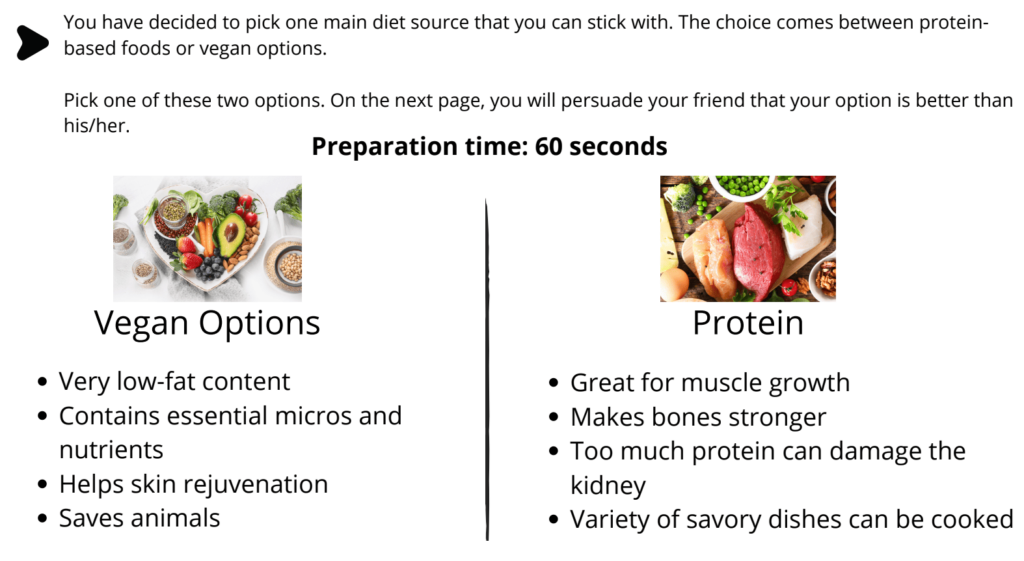
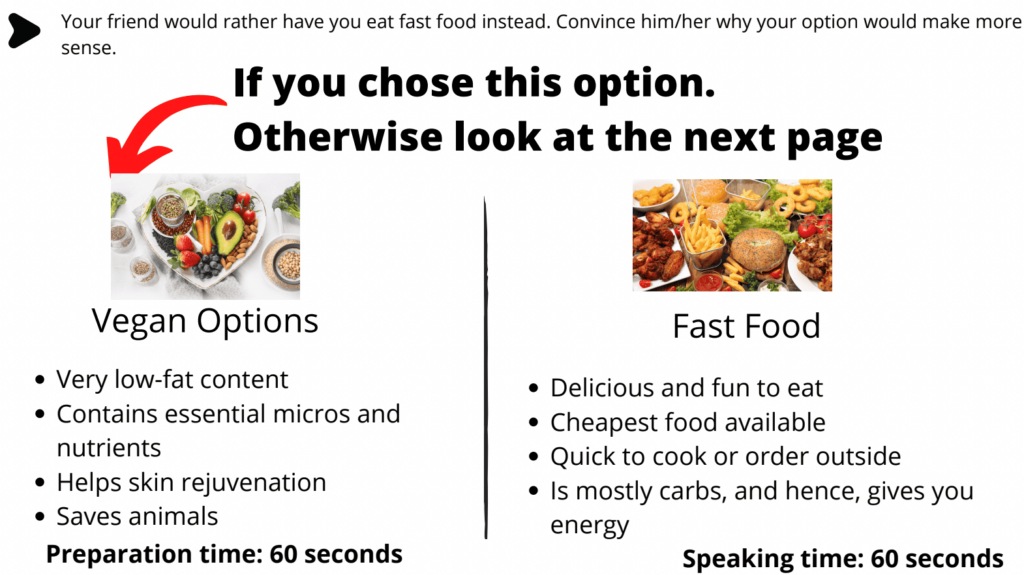
Tips to Answer the Question:
- Focus on countering your friend’s points: Explain why fast food is unhealthy or not the best choice.
- Highlight the advantages of vegan options: Use the points provided to showcase the health and ethical benefits.
- Structure your argument clearly: Begin by addressing the drawbacks of fast food, then emphasize the benefits of vegan choices.
Sample Answer
Hey Bob, I understand that fast food seems like a convenient and fun choice, but let me explain why going for vegan options is a much better idea. Fast food might be cheap and give you a quick energy boost, but it’s mostly empty calories, unhealthy fats, and processed ingredients. In the long run, this can lead to health problems like weight gain and sluggishness. You’ll feel a quick burst of energy, sure, but it will fade fast and leave you feeling tired.
In contrast, vegan food is rich in essential nutrients that your body needs, such as vitamins and minerals. It helps with skin rejuvenation and overall health, something fast food can’t provide. Plus, it’s ethically better because it saves animals and reduces environmental harm. So, instead of choosing fast food, go for vegan meals that fuel your body and make you feel better in the long term. Trust me, you’ll thank yourself later!
________________________________________________________________________________________________________________
Trending CELPIP Speaking Tips and Tricks Video: https://www.youtube.com/watch?v=km2Q3Bs2qYs
________________________________________________________________________________________________________________
Question 6:
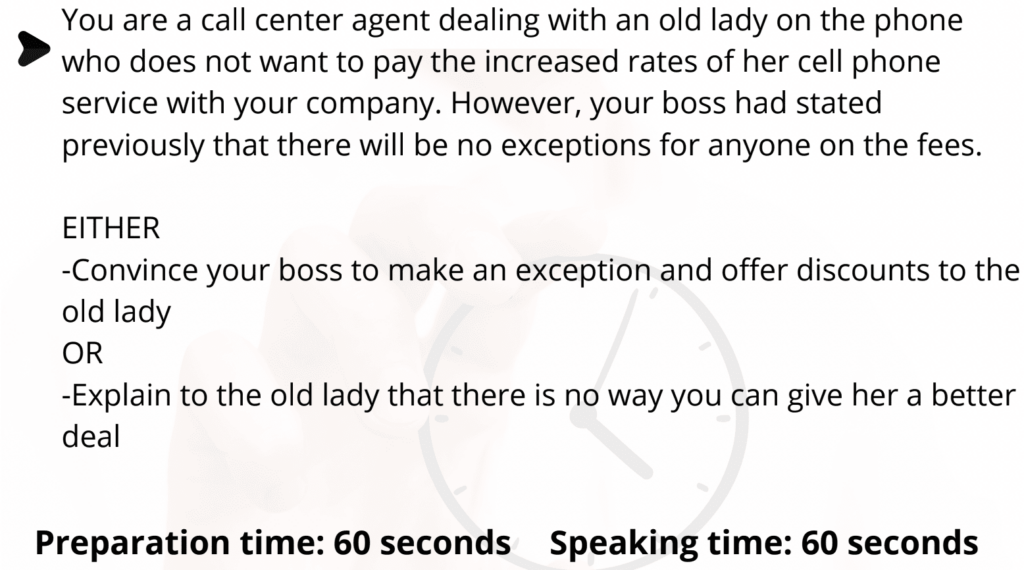
Tips to Answer the Question:
- Choose one option clearly: Either persuade your boss or explain the situation to the old lady.
- Use empathy and reasoning: If you choose the boss, focus on fairness and customer satisfaction. If addressing the old lady, be respectful and clear.
- Structure the argument: Present your reasoning logically, leading to a clear conclusion.
Sample Answer
Convincing the Boss
Hi [Boss’s Name], I understand that we have a strict no-exceptions policy regarding fee increases, but I believe we should consider making an exception for this elderly customer. She’s been a loyal client for several years, and she’s struggling financially. Offering her a small discount or a special plan would show that we value our long-term customers and are empathetic to their personal situations.
Additionally, this small act of kindness could prevent her from switching to another provider, which would result in a loss of revenue for us. Taking care of customers like her could also enhance our company’s reputation as one that genuinely cares about its clients, which can lead to positive word-of-mouth and long-term benefits.
I really think that by making this exception, we’ll not only retain a loyal customer but also strengthen our customer relations. Please consider this request— it could make a big difference.
Question 7:

Tips to Answer the Question:
- Choose a clear stance: Decide whether to support or oppose the elimination of vacation pay and stick to it.
- Identify three strong reasons: Ensure each reason is distinct and supports your main argument effectively.
- Use advanced vocabulary and structures: Incorporate sophisticated language and varied sentence structures to demonstrate language proficiency.
- Provide concrete examples or evidence: Strengthen your arguments with relevant examples or data.
- Maintain coherence and cohesion: Ensure the answer flows logically from one point to the next, using appropriate linking words.
Sample Answer
I firmly oppose the elimination of vacation pay, as it is indispensable for fostering employee well-being, enhancing productivity, and ensuring organizational loyalty. Firstly, vacation pay is crucial for employee well-being. Paid time off allows individuals to rest and recharge, reducing stress and preventing burnout. This not only improves their mental and physical health but also contributes to a more positive work environment.
Secondly, providing vacation pay significantly enhances productivity. When employees have the opportunity to take regular breaks, they return to work rejuvenated and more focused. This increased concentration leads to higher quality work and greater efficiency, ultimately benefiting the company’s overall performance.
Thirdly, vacation pay plays a vital role in cultivating organizational loyalty. When employers invest in their employees’ time off, it demonstrates a commitment to their workforce’s happiness and satisfaction. This fosters a sense of appreciation and loyalty, reducing turnover rates and retaining valuable talent within the company.
In conclusion, maintaining vacation pay is essential for ensuring the health and satisfaction of employees, boosting productivity, and fostering long-term loyalty. Eliminating this benefit would not only harm the workforce but also undermine the success and sustainability of businesses.
Question 8:
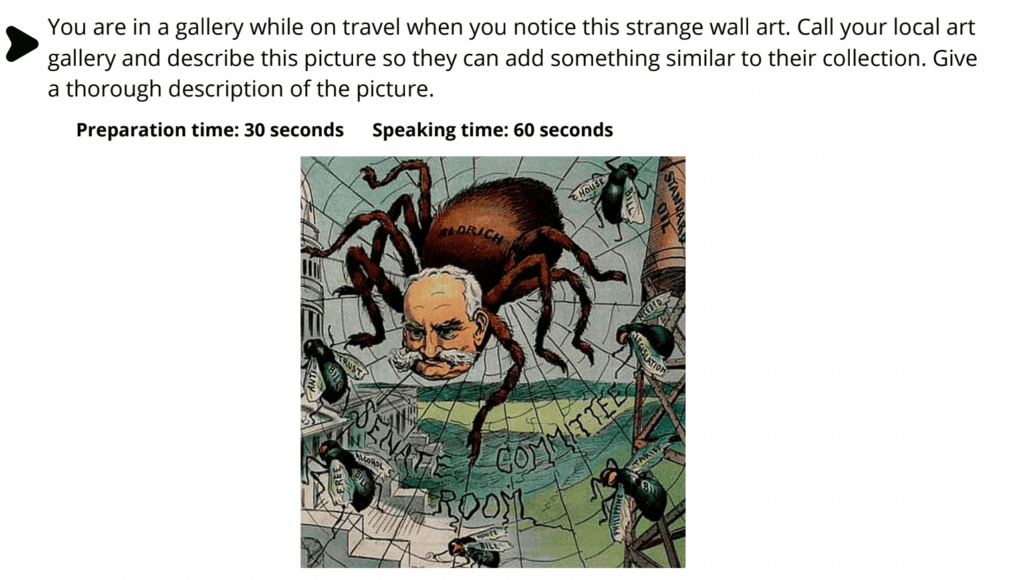
FINAL SECTION: CELPIP WRITING TIPS AND TRICKS!
The CELPIP writing section contains two tasks.
-Task 1 is a formal or informal email.
-Task 2 is an essay to be written based on an opinion survey.
-Both tasks require you to use 150-200 words. The ideal word limit here is 180! Also, each task gives you about 26-27 minutes to complete.
—At this point, let me reward you with something! Sean’s complete CELPIP Writing Playlist! This playlist has tons of videos with details on very specific CELPIP writing questions, tips, tricks, vocabulary, strategy, marking criteria, and more! Here you go: https://www.youtube.com/watch?v=_Wc3xPJKM_w&list=PLWF0AW0Ncw0TIVeTEs3Jp-Do5Nn75XpBZ
CELPIP Writing Task 1:
For CELPIP writing task 1, you will get either a formal email question (most common) or an informal one. It’s simple. If it’s written to friends or family, it’s informal. Anyone else is formal.
Okay, then what about a neighbor? Well, if the question mentions that you know the neighbor, it’s informal and otherwise, it’s formal.
Simple! There is no semiformal in CELPIP. Just keep the informal and formal formats in your mind.
Guidelines for CELPIP Writing Task 1
You will be asked to write an email, either formal or informal. Here’s how to approach each style:
Formal Email
1. Salutation
- Use a formal greeting.
- Example: “Dear Sir/Madam,” or “Dear Mr. Brown,”
2. Introduction
- State the purpose of your email briefly.
- Example: “I am writing to apply for the position advertised…”
3. Body
- Provide details in clear, organized paragraphs.
- Example: “With over five years of experience in finance, I have developed skills in…”
4. Conclusion
- Summarize your message politely.
- Example: “I appreciate your consideration and look forward to your response.”
5. Closing
- Use a formal sign-off.
- Example: “Sincerely,” or “Regards,” followed by your full name.
Informal Email
1. Salutation
- Use a casual greeting.
- Example: “Hi Alex,” or “Hey Emily,”
2. Introduction
- Start with a friendly opener.
- Example: “Hope you’re doing well!”
3. Body
- Write in a conversational tone.
- Example: “I’m thinking of visiting next month. Do you have time to meet up?”
4. Conclusion
- End with a personal note.
- Example: “Can’t wait to catch up!”
5. Closing
- Use an informal sign-off.
- Example: “Best,” or “Cheers,” followed by your first name.
Tips:
- Word Count: Aim for about 180 words.
- Tone: Match the tone to the recipient (formal vs. informal).
- Content: Address all points mentioned in the task prompt.
- Clarity: Keep sentences clear and to the point.
- Grammar and Spelling: Proofread to avoid errors.
200 Top CELPIP Writing Task 1 Questions: https://hzadeducation.com/2024/08/13/200-top-celpip-writing-task-1-questions/
200 Top CELPIP Writing Task 2 Questions: https://hzadeducation.com/2024/08/20/200-top-celpip-writing-task-2-questions/
CELPIP WRITING SAMPLES FOR TASK 1:
Formal Email Question:
You recently attended a seminar on environmental conservation organized by a local organization. You were dissatisfied with several aspects of the seminar. Write an email to the organizer to express your concerns. In your email:
- Describe what the seminar was about.
- Explain why you were dissatisfied.
- Suggest how the seminar could be improved.
Sample Answer:
Dear Sir/Madam,
I am writing to express my concerns regarding the environmental conservation seminar held on October 10th by your organization. As someone deeply interested in environmental issues, I was eager to attend and learn more about local conservation efforts.
However, I found several aspects of the seminar disappointing. Firstly, the venue was overcrowded, making it difficult to see the presentations or hear the speakers clearly. Secondly, the content lacked depth; the topics covered were quite basic and did not provide new insights for those already familiar with environmental issues. Lastly, there were frequent technical difficulties with the audio-visual equipment, which disrupted the flow of the seminar.
To improve future events, I suggest limiting the number of attendees to ensure a more comfortable environment. Additionally, including advanced topics or workshops would cater to a wider range of knowledge levels. Ensuring that all equipment is tested beforehand would also prevent unnecessary interruptions.
I appreciate your efforts in organizing events on such important topics and hope my feedback will contribute to their enhancement.
Sincerely,
[Your Full Name]
Informal Email Question:
Your friend is planning to visit your city for the first time and has asked for your advice on places to see and things to do. Write an email to your friend. In your email:
- Recommend some attractions to visit.
- Suggest activities to do.
- Offer to help during their visit.
Sample Answer:
Hi Sarah,
Great to hear you’re visiting next month! It’s been so long since we last met, and I can’t wait to catch up and show you around.
You should definitely visit the art museum downtown; they have an amazing modern art exhibit right now. Also, the botanical gardens are beautiful this season with all the spring flowers in bloom. If you’re into history, the old fort by the river offers fascinating tours and stunning views of the city.
For activities, we could go hiking in the nearby national park. The trails are lovely, and the weather should be perfect. Remember our college hiking trips? It would be fun to relive those memories. Alternatively, there’s a new cooking class teaching local dishes—it could be a delicious way to spend an afternoon. There’s also a food festival the weekend you’re here, a great chance to try local specialties.
Let me know if you’d like to stay at my place—I have a spare room, and you’re more than welcome. If you need help planning your trip or getting around, just let me know. I’d be happy to pick you up from the airport or show you the best spots around town. Can’t wait to see you!
Cheers,
[Your First Name]
CELPIP WRITING TASK 2:
QUESTION:
The federal government is considering the most reasonable option for punishing criminals. It believes that capital punishment may deter crime but is too harsh to implement. They are also weighing the pros and cons of life imprisonment.
Please write 150-200 words providing your opinion on the selected option:
A: CAPITAL PUNISHMENT
B: LIFE IMPRISONMENT
The above is a typical writing task 2 question where two options are presented and you need to pick one. When asked to choose between two options and provide your opinion, consider the following structure:
- Introduction
- Briefly introduce the topic.
- Clearly state your opinion on the selected option.
- First Supporting Point
- Present a strong reason for your choice.
- Include examples or explanations to support it.
- Second Supporting Point
- Offer another compelling reason.
- Provide additional details or evidence.
- Address the Alternative
- Acknowledge the other option.
- Explain why it is less favorable compared to your choice.
- Conclusion
- Summarize your main arguments.
- Reinforce your opinion.
CELPIP WRITING SAMPLE FOR TASK 2:
The government’s consideration of appropriate penalties for criminals has raised an important debate between implementing capital punishment and opting for life imprisonment. I firmly believe that life imprisonment is the more suitable choice.
Firstly, life imprisonment allows for the possibility of rehabilitation. Individuals sentenced to life have the opportunity to reflect on their actions and potentially contribute positively while incarcerated. This not only upholds moral values but also aligns with the principles of a just society that believes in second chances.
Secondly, the risk of wrongful convictions cannot be overlooked. History has shown instances where innocent people were sentenced to death, only for evidence to emerge later proving their innocence. Life imprisonment ensures that, should new evidence arise, corrective action can still be taken.
While capital punishment might seem like a strong deterrent, there is little conclusive evidence to support its effectiveness in reducing crime rates. Moreover, it raises ethical concerns about the state taking a life, which can be seen as contradictory to the very laws that condemn murder.
In conclusion, life imprisonment serves as a humane and reversible penalty that upholds justice without crossing ethical boundaries. Therefore, it stands as the more reasonable option for addressing serious offences.
Brief Breakdown of Why this Sample Answer Scores High Marks in CELPIP
- Task Fulfillment:
- Directly answers the question by choosing life imprisonment and providing a clear opinion.
- Addresses both supporting arguments for the choice and counters the alternative option.
- Organization:
- Follows a logical structure with an introduction, two body paragraphs, and a conclusion.
- Each paragraph has a clear purpose, enhancing readability.
- Content and Ideas:
- Provides strong reasons for supporting life imprisonment (rehabilitation potential and risk of wrongful convictions).
- Acknowledges and refutes the opposing view on capital punishment effectively.
- Language Use:
- Utilizes appropriate and varied vocabulary suitable for a formal essay.
- Demonstrates control over grammar and sentence structures, including complex sentences.
- Coherence and Cohesion:
- Uses transitional words like “Firstly,” “Secondly,” and “In conclusion” to connect ideas smoothly.
- Maintains a consistent and formal tone throughout the essay.
- Word Count:
- Stays within the 150-200 word limit, showing the ability to express ideas concisely.
Follow the above structures and guidelines for task 1 and task 2 writing to score the maximum marks! Also, note that HZad Education offers COMPLETELY FREE CELPIP WRITING EVALUATIONS MARKED BY CELPIP EXPERTS! To get yours assessed for free, email us at [email protected] with your writing sample!
Want more CELPIP Writing and Speaking Samples?
Here are some free resources where you can find more sample answers by HZad Education:
Speaking:
https://www.youtube.com/watch?v=ATQSPWJb0k8
https://www.youtube.com/watch?v=PXRmcv8wSEc&t=6s
https://www.youtube.com/watch?v=ncggXaflURU&t=345s
https://www.youtube.com/watch?v=UHYm1_66ZFo&t=41s
https://www.youtube.com/watch?v=InHn-j8Z17k&t=361s
https://hzadeducation.com/2023/11/21/celpip-speaking-samples-with-details/
Writing:
https://www.youtube.com/watch?v=Dl1pg5TpjoQ&t=17s
https://www.youtube.com/watch?v=tVvuCUuAZwc&t=2s
https://hzadeducation.com/2024/02/09/celpip-writing-best-sample-answers/
However, if you want the most detailed sample answers with the best breakdown (complete detail on how to score 9+ with specific words and phrases), go for this package: https://hzadeducation.com/product/celpip-39-upgrade-materials-and-feedback/. It also includes 5 additional, highly challenging mock tests.
You will find the complete details on the page.
Common CELPIP FAQS:
- What is the CELPIP test?
CELPIP (Canadian English Language Proficiency Index Program) is an English language proficiency test designed to assess language skills for immigration, citizenship, or professional purposes.
- How many sections are in the CELPIP test?
The CELPIP test has four sections: Listening, Reading, Writing, and Speaking. Each section evaluates different aspects of English proficiency.
- How long is the CELPIP test?
The CELPIP test takes approximately 3 hours. Listening is 47-55 minutes, Reading is 55-60 minutes, Writing is 53-60 minutes, and Speaking is 15-20 minutes.
- What score do I need for Canadian immigration?
Typically, a CLB (Canadian Language Benchmark) level of 7 or higher is required for immigration, but the specific score depends on the immigration program.
- How is the CELPIP test scored?
CELPIP is scored on a scale from 1 to 12, with each score corresponding to a CLB level. A score of 12 indicates advanced proficiency.
- Can I retake the CELPIP test?
Yes, you can retake the CELPIP test as often as needed. There is usually a waiting period of a few days between test attempts.
- How long are my CELPIP scores valid?
CELPIP scores are valid for two years from the date of the test.
- What is the difference between CELPIP-General and CELPIP-LS?
CELPIP-General tests Listening, Reading, Writing, and Speaking, while CELPIP-LS only assesses Listening and Speaking and is used primarily for Canadian citizenship applications.
- Can I take the CELPIP test online?
No, the CELPIP test is computer-based but must be taken at an official test center. It is not available for online completion from home.
- How much does the CELPIP test cost?
The cost of the CELPIP test varies by location but generally ranges from CAD 280 to CAD 350.
- How can I prepare for the CELPIP test?
You can prepare by taking official CELPIP practice tests, watching online tutorials, attending preparation courses, and using study guides from resources like HZad Education.
- What types of questions are in the CELPIP Listening section?
The Listening section includes tasks such as listening to conversations, problem-solving, news items, and discussions, and requires extracting information from spoken English.
- What types of questions are in the CELPIP Reading section?
The Reading section includes tasks like reading correspondence, applying information from a diagram, reading for specific information, and understanding viewpoints.
- What are the tasks in the CELPIP Writing section?
The Writing section includes tasks such as writing an email and responding to survey questions. It assesses your ability to write coherent, well-structured responses.
- What are the tasks in the CELPIP Speaking section?
The Speaking section involves tasks such as giving advice, talking about personal experiences, making predictions, and expressing opinions. It evaluates your fluency and ability to communicate in different situations.
- What should I bring to the CELPIP test?
You should bring a valid, government-issued photo ID (such as a passport or driver’s license) and your test confirmation email. Personal items like cell phones and bags are typically not allowed in the test room.
- How is the CELPIP test different from IELTS?
CELPIP is entirely computer-based and focuses more on Canadian English in everyday contexts. IELTS includes paper-based and computer-based options, with a broader international focus in its content.
- Can I cancel or reschedule my CELPIP test?
Yes, you can cancel or reschedule your CELPIP test, but there may be a fee, and you must meet the deadline for changes (usually a few days before the test date).
- How soon will I receive my CELPIP test results?
CELPIP test results are typically available online 4-5 calendar days after the test date.
- How do I register for the CELPIP test?
You can register for the CELPIP test on the official CELPIP website by selecting your preferred test center, date, and time.
#HZadEducation #CELPIP #CelpipTips #CelpipGuide #CELPIPExam #CELPIPPreparation #CLB10 #CelpipPractice #CelpipSuccess #CELPIPTIPSANDTRICKS
www.hzadeducation.com


